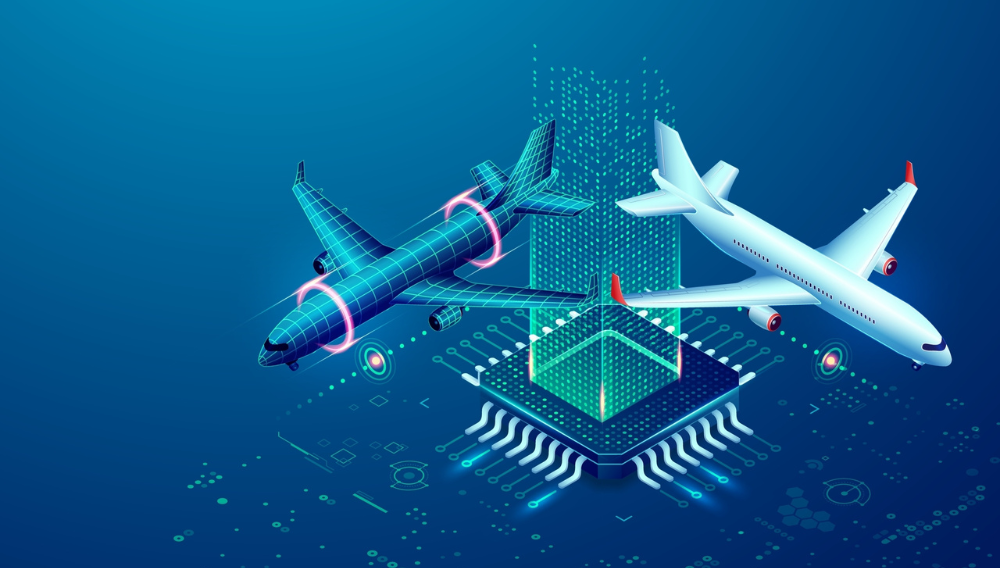5 min read
RTI Connext for Digital Twins: Bridging the Gap Between Virtual Systems and Physical Objects in Real Time
 Rob Proctor
:
June 4, 2024
Rob Proctor
:
June 4, 2024

The only second language that I really speak fluently is acronym. Specifically military acronym. And as with any other language, there are words and phrases which are the same, but have multiple meanings. In the whirlwind of overloaded terms and acronyms that inundate my daily life, one stands out not only for its buzzworthy nature but for its profound impact on shaping the future of multiple industries: DT, otherwise known as digital twin.
At RTI, overloaded acronyms are quite common, especially for our beloved Data Distribution Service (DDS™) standard. Digital twins however, have two main meanings for the context and what is being represented as a digital twin. Therefore, some clarification on the definition for “digital twin” would be useful. As of today, there are two main definitions, each gaining traction within their respective circles. The lack of a unified definition has limited the full adoption of either version in systems.
The Two Main Definitions of Digital Twins
According to Gartner, the term DT is thought of as an encapsulated software object or model that mirrors a unique physical object, process, organization, person or other abstraction.1 The overloading of the term arose because the concept of a digital twin has evolved and diversified over time, leading to different interpretations and applications. There are however generally two main agreed upon definitions of Digital Twins.
The Digital Twin Consortium has a definition that they are promoting, but in parallel the Game Engines along with organizations like the VRARA also have a definition that they are supporting, separately. Until these two groups can co-mingle, there will continue to be the two main competing definitions. What are these competing DT ideas? Let’s define them and give examples of how RTI Connext enables them.
1. A 3D Model of a Physical Object:
From Epic Games perspective: www.unrealengine.com/en-US/digital-twins
From a gaming perspective, DT refers to the creation of a three-dimensional virtual environment that closely resembles the physical space it resides in and enables realistic simulations and interactions using game engines or similar technologies to create. Being a fan of Marvel and the MCU, I think of this version of a DT as the "Tony Stark" version. In several MCU movies, Tony would create a rendering of something that he intended to build in a “spatial” environment, he could spin it around and look at it from 360 degrees. In this context the term "spatial" refers to the three-dimensional (3D) environment or space in which the virtual replica of a physical object, system, or environment is created. This replica is often created using advanced modeling and simulation techniques, including game engines such as Epic Games® Unreal Engine® and Unity®.
The purpose of such a DT is to provide an environment where one can experiment, test, or simulate real-world scenarios without having to directly interact with the physical object. For example, a DT of a large airport might be created using a game engine to simulate various operating conditions and optimize processes. Other common use cases for these DT are creating environments for experimentation of as yet to be built objects and for creating simulators for training purposes.
Use Case: Innovative Connext Demo Shows Digital Twin of a Surgical Robot
RTI Demo of a medical digital twin
RTI recently collaborated on an exciting medical robot demo, which featured the integration of an off-the-shelf robotic arm with patient monitoring screens and a digital twin. This proof-of-concept illustrates Connext's transformative impact in surgical robotics by bridging disparate systems, enabling effortless device interoperability and real-time simulation integration crucial for surgical robotics training and remote surgical procedures. This demo is a key resource for events such as Embedded World, Device Talks and Hamlyn Symposium and can be extended to show non-medical applications as well.
2. Virtual Representation of a Physical Component or an Entire System:

From the Digital Twin Consortium perspective: www.digitaltwinconsortium.org/initiatives/the-definition-of-a-digital-twin/
A second common interpretation of a DT refers to a virtual representation of a physical system or device that is continuously updated with real-time data from actual cyber-physical objects and sensors. The expected outputs from real-world inputs to this DT should be identical to what an actual real-world system would produce and in the same amount of time. Think of the simplest of instruction set simulators or a virtual machine, but now make that for entire complex systems. Creating multiple real-world systems for development and testing might be cost prohibitive. But with a DT of this environment, you can save on costs and on development time. This DT mirrors the behavior, status, and performance of the real-world physical asset, leveraging actual IoT sensors, data analytics, and other technologies to capture and process relevant information. The primary purpose of such DT is to monitor, analyze, and optimize the performance of the physical asset or system.
Use Case: SMART Headlights with RTI Connext Drive and Ansys
Sören Schreiner from Ansys showcasing a digital twin joint demo with RTI, recently displayed at Embedded World 2024. The integration of RTI Connext with Ansys SCADE enables engineers to design and test their systems against real-world scenarios in secure, highly-scalable digital twin environments
This demo illustrates real-time communication between a smart headlights application and its digital twin. RTI Connext Drive works seamlessly with ANSYS tools to deliver the real-time data exchange to configure Matrix/Pixel headlights. This design precision and reliability helps to shorten the feedback loop, reduce risk, and accelerate project success.
Data-Centric Communication is What Gives Life to Any Definition of a Digital Twin
No matter which definition you are referring to, or even if you plan to combine multiple components of DT types into a single system, RTI Connext can deliver real-time authoritative data, as it’s built on the Object Management Group® (OMG®) Data Distribution Service standard. This data-centric standard plays an essential role for getting the most out of any system that employs a single DT or thousands working together. In a data-centric system, data from multiple digital twins can be aggregated for a composite view across a number of real-world entities, such as a power plant or a smart city, and their related processes.
The essence of any DT hinges on its ability to seamlessly interact with its real-world counterpart. Whether conceptualized as intricate 3D models of physical entities or as virtual representations of complex systems, having data delivered by Connext at its proper "twinning speed" is what will give a DT life. The backbone enabling any DT’s functionality lies in robust interoperable data-centric communication. RTI Connext shines here, actively facilitating dynamic, synchronized data sharing among interconnected DT and cyber physical entities.
Digital Twins in the Defense Industry
The defense community is also embracing Digital Twins. The immediate benefit of Digital Twins for Defense would be interoperability, enabling a convergence between the modeling and simulation, test, and engineering communities. This would dovetail neatly with efforts to create a standard that could be shared across the Joint Forces, encompassing a DT connectivity framework based on DDS, the DTC Digital Twin System Interoperability Framework, and the Army’s Unified Data Reference Architecture (A-UDRA). By leveraging DDS, this proposed open standard for DTs can help ensure interoperability, scalability, and security across defense applications.
Connext already delivers this functionality in real-world systems, and can apply the same approach for Digital Twins by accurately mirroring the physical object or enabling virtual representations to communicate seamlessly within an integrated system. This would allow the seamless movement of data between live systems and DTs, speeding systems development. Initiatives such as the Rapid Autonomy Integration Lab (RAIL) for maritime autonomy are underway today. At RAIL, DTs run in the cloud and are tested there; the same components can then be dropped onto real platforms and communicate the same way. Connext plays a pivotal role in realizing the full potential of DT by fostering interoperability and enabling real-time data exchange.
An Assessment of Digital Twin Readiness Across the DoD
If you’re interested in learning more about the use of DTs within the U.S. Department of Defense (DoD), then join me for the 2024 MOSA Industry & Government Summit & Expo in Washington DC, June 17-18, where I will be speaking on a panel covering the latest technical innovations with DT readiness across the DoD. This panel will bring government and industry experts together to discuss the current state of the art with respect to digital twins across the DoD. Topics include taxonomy, interfacing, data engineering, and architectures. To learn more about how RTI Connext supports the goals of MOSA, please click here.
1 Definition of Digital Twin from Gartner: https://www.gartner.com/en/information-technology/glossary/digital-twin
About the author:
 Rob Proctor is a Staff Field Application Engineer for Real-Time Innovations. He has over 28 years of experience in A&D Embedded Software as a Software Engineer and Field Applications Engineer. Prior to his time as a Field Application Engineer, he developed and implemented real time embedded software at major Aerospace and Defense Corporations. His roles have included developing software and system designs, mission-management and display processing systems. Rob received his BS from Embry-Riddle Aeronautical University in Aerospace Studies and his MS from the University of South Florida in Engineering Management.
Rob Proctor is a Staff Field Application Engineer for Real-Time Innovations. He has over 28 years of experience in A&D Embedded Software as a Software Engineer and Field Applications Engineer. Prior to his time as a Field Application Engineer, he developed and implemented real time embedded software at major Aerospace and Defense Corporations. His roles have included developing software and system designs, mission-management and display processing systems. Rob received his BS from Embry-Riddle Aeronautical University in Aerospace Studies and his MS from the University of South Florida in Engineering Management.
Posts by Tag
- Developers/Engineer (177)
- Connext DDS Suite (77)
- Technology (74)
- News & Events (73)
- 2020 (54)
- Standards & Consortia (51)
- Aerospace & Defense (48)
- Automotive (35)
- 2023 (34)
- 2022 (29)
- IIoT (27)
- Leadership (24)
- 2024 (22)
- Cybersecurity (20)
- Healthcare (20)
- 2021 (19)
- Connectivity Technology (16)
- Military Avionics (15)
- Culture & Careers (14)
- FACE (13)
- Connext DDS Pro (10)
- JADC2 (10)
- ROS 2 (10)
- 2025 (8)
- Connext DDS Tools (7)
- Connext DDS Micro (6)
- Databus (6)
- Transportation (5)
- Case + Code (4)
- Connext DDS (4)
- Connext DDS Cert (4)
- Energy Systems (4)
- FACE Technical Standard (4)
- Oil & Gas (3)
- RTI Labs (3)
- Research (3)
- Robotics (3)
- #A&D (2)
- Connext Conference (2)
- Edge Computing (2)
- MDO (2)
- MS&T (2)
- TSN (2)
- ABMS (1)
- C4ISR (1)
- ISO 26262 (1)
- L3Harris (1)
- LabView (1)
- MathWorks (1)
- National Instruments (1)
- Simulation (1)
- Tech Talks (1)
- UAM (1)
- Videos (1)
- eVTOL (1)
 Success-Plan Services
Success-Plan Services